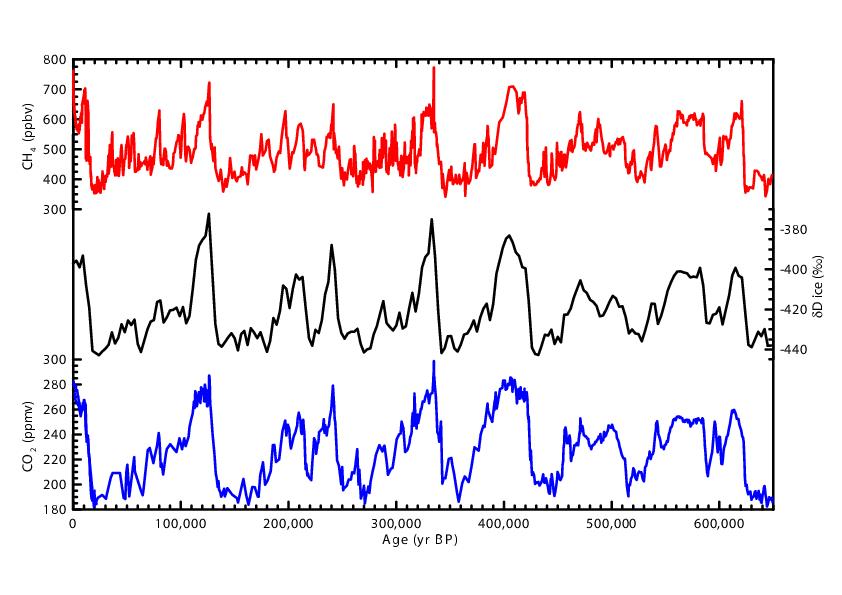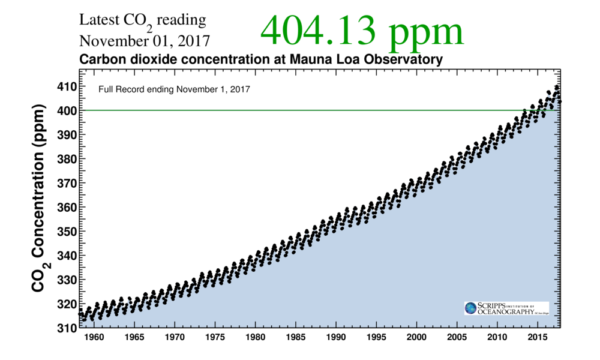Some of you might have read about the lawsuit by a number of municipalities (including San Francisco and Oakland) against the major oil companies for damages (related primarily to sea level rise) caused by anthropogenic climate change. The legal details on standing, jurisdiction, etc. are all very interesting (follow @ColumbiaClimate for those details), but somewhat uniquely, the judge (William Alsup) has asked for a tutorial on climate science (2 hours of evidence from the plaintiffs and the defendents). Furthermore, he has posted a list of eight questions that he’d like the teams to answer.
Carbon cycle
The global CO2 rise: the facts, Exxon and the favorite denial tricks
The basic facts about the global increase of CO2 in our atmosphere are clear and established beyond reasonable doubt. Nevertheless, I’ve recently seen some of the old myths peddled by “climate skeptics” pop up again. Are the forests responsible for the CO2 increase? Or volcanoes? Or perhaps the oceans?
Let’s start with a brief overview of the most important data and facts about the increase in the carbon dioxide concentration in the atmosphere:
- Since the beginning of industrialization, the CO2 concentration has risen from 280 ppm (the value of the previous millennia of the Holocene) to now 405 ppm.
- This increase by 45 percent (or 125 ppm) is completely caused by humans.
- The CO2 concentration is thus now already higher than it has been for several million years.
- The additional 125 ppm CO2 have a heating effect of 2 watts per square meter of earth surface, due to the well-known greenhouse effect – enough to raise the global temperature by around 1°C until the present.
Fig. 1 Perhaps the most important scientific measurement series of the 20th century: the CO2 concentration of the atmosphere, measured on Mauna Loa in Hawaii. Other stations of the global CO2 measurement network show almost exactly the same; the most important regional variation is the greatly subdued seasonal cycle at stations in the southern hemisphere. This seasonal variation is mainly due to the “inhaling and exhaling” of the forests over the year on the land masses of the northern hemisphere. Source (updated daily): Scripps Institution of Oceanography. [Read more…] about The global CO2 rise: the facts, Exxon and the favorite denial tricks
O Say Can You CO2…
Guest Commentary by Scott Denning
The Orbiting Carbon Observatory (OCO-2) was launched in 2014 to make fine-scale measurements of the total column concentration of CO2 in the atmosphere. As luck would have it, the initial couple of years of data from OCO-2 documented a period with the fastest rate of CO2 increase ever measured, more than 3 ppm per year (Jacobson et al, 2016;Wang et al, 2017) during a huge El Niño event that also saw global temperatures spike to record levels.
As part of a series of OCO-2 papers being published this week, a new Science paper by Junjie Liu and colleagues used NASA’s comprehensive Carbon Monitoring System to analyze millions of measurements from OCO-2 and other satellites to map the impact of the 2015-16 El Niño on sources and sinks of CO2, providing insight into the mechanisms controlling carbon-climate feedback.
[Read more…] about O Say Can You CO2…
References
- J. Wang, N. Zeng, M. Wang, F. Jiang, H. Wang, and Z. Jiang, "Contrasting terrestrial carbon cycle responses to the two strongest El Niño events: 1997–98 and 2015–16 El Niños", 2017. http://dx.doi.org/10.5194/esd-2017-46
- J. Liu, K.W. Bowman, D.S. Schimel, N.C. Parazoo, Z. Jiang, M. Lee, A.A. Bloom, D. Wunch, C. Frankenberg, Y. Sun, C.W. O’Dell, K.R. Gurney, D. Menemenlis, M. Gierach, D. Crisp, and A. Eldering, "Contrasting carbon cycle responses of the tropical continents to the 2015–2016 El Niño", Science, vol. 358, 2017. http://dx.doi.org/10.1126/science.aam5690
1.5ºC: Geophysically impossible or not?
Guest commentary by Ben Sanderson
Millar et al’s recent paper in Nature Geoscience has provoked a lot of lively discussion, with the authors of the original paper releasing a statement to clarify that their paper did not suggest that “action to reduce greenhouse gas emissions is no longer urgent“, rather that 1.5ºC (above the pre-industrial) is not “geophysically impossible”.
The range of post-2014 allowable emissions for a 66% chance of not passing 1.5ºC in Millar et al of 200-240GtC implies that the planet would exceed the threshold after 2030 at current emissions levels, compared with the AR5 analysis which would imply most likely exceedance before 2020. Assuming the Millar numbers are correct changes 1.5ºC from fantasy to merely very difficult.
But is this statement overconfident? Last week’s post on Realclimate raised a couple of issues which imply that both the choice of observational dataset and the chosen pre-industrial baseline period can influence the conclusion of how much warming the Earth has experienced to date. Here, I consider three aspects of the analysis – and assess how they influence the conclusions of the study.
[Read more…] about 1.5ºC: Geophysically impossible or not?
…the Harde they fall.
Back in February we highlighted an obviously wrong paper by Harde which purported to scrutinize the carbon cycle. Well, thanks to a crowd sourced effort which we helped instigate, a comprehensive scrutiny of those claims has just been published. Lead by Peter Köhler, this included scientists from multiple disciplines working together to clearly report on the mistaken assumptions in the Harde paper.
The comment is excellent, and so should be well regarded, but the fact that it is a comment means that the effort will likely be sorely underappreciated. Part of problem is the long time for the process (almost 8 months) which means that the nonsense is mostly forgotten about by the time the comments are published. We’ve discussed trying to speed up and improve the process by having a specialized journal for comments and replications but really the problem here is the low quality of peer review and editorial supervision that allows these pre-rebunked papers to appear in the first place.
GPC is not the only (nor the worst) culprit for this kind of nonsense – indeed we just noticed a bunch of astrology papers in the International Journal of Heat and Technology (by Nicola Scatetta [natch]). It does seem to demonstrate that truly you can indeed publish anything somewhere.
References
- P. Köhler, J. Hauck, C. Völker, D.A. Wolf-Gladrow, M. Butzin, J.B. Halpern, K. Rice, and R.E. Zeebe, "Comment on “ Scrutinizing the carbon cycle and CO 2 residence time in the atmosphere ” by H. Harde", Global and Planetary Change, vol. 164, pp. 67-71, 2018. http://dx.doi.org/10.1016/j.gloplacha.2017.09.015
Climate Sensitivity Estimates and Corrections
You need to be careful in inferring climate sensitivity from observations.
Two climate sensitivity stories this week – both related to how careful you need to be before you can infer constraints from observational data. (You can brush up on the background and definitions here). Both cases – a “Brief Comment Arising” in Nature (that I led) and a new paper from Proistosescu and Huybers (2017) – examine basic assumptions underlying previously published estimates of climate sensitivity and find them wanting.
[Read more…] about Climate Sensitivity Estimates and Corrections
References
- C. Proistosescu, and P.J. Huybers, "Slow climate mode reconciles historical and model-based estimates of climate sensitivity", Science Advances, vol. 3, 2017. http://dx.doi.org/10.1126/sciadv.1602821
Something Harde to believe…
A commenter brings news of an obviously wrong paper that has just appeared in Global and Planetary Change. The paper purports to be a radical revision of our understanding of the carbon cycle by Hermann Harde. The key conclusions are (and reality in green):
- The average residence time of CO2 in the atmosphere is found to be 4 years.
[The residence time for an individual molecule is not the same as the perturbation response time of the carbon cycle which has timescales of decades to thousands of years.]
- The anthropogenic fraction of CO2 in the atmosphere is only 4.3%.
[Actually, it’s 30%.]
- Human emissions only contribute 15% to the CO2 increase over the Industrial Era.
[It’s all of it.]
Since these points contradict multiple independent sources of evidence, I can, without hesitation, predict that there are fundament flaws in this paper that will raise serious questions about the quality of the peer-review that this paper went through. Oddly, this paper is labeled as an “Invited Research Article” and so maybe some questions might be asked of the editor responsible too.
Notwithstanding our last post on the difficulty in getting comments published, this paper is crying out for one.
But this kind of thing has been done before, does not require any great sophistication or computer modeling to rebut, and has come up so many times before (Salby (also here), Beck, Segalstad, Jaworowski etc.), that perhaps a crowd-sourced rebuttal would be useful.
So, we’ll set up an overleaf.com page for this (a site for collaborative LaTeX projects), and anyone who wants to contribute should put the gist of their point in the comments and we’ll send the link so you can add it to the draft. Maybe the citizen scientists among you can pull together a rebuttal faster than the professionals?
Update: The crowd-sourced comment has appeared Köhler et al (2018).
References
- H. Harde, "Scrutinizing the carbon cycle and CO2 residence time in the atmosphere", Global and Planetary Change, vol. 152, pp. 19-26, 2017. http://dx.doi.org/10.1016/j.gloplacha.2017.02.009
- P. Köhler, J. Hauck, C. Völker, D.A. Wolf-Gladrow, M. Butzin, J.B. Halpern, K. Rice, and R.E. Zeebe, "Comment on “ Scrutinizing the carbon cycle and CO 2 residence time in the atmosphere ” by H. Harde", Global and Planetary Change, vol. 164, pp. 67-71, 2018. http://dx.doi.org/10.1016/j.gloplacha.2017.09.015
Why correlations of CO2 and Temperature over ice age cycles don’t define climate sensitivity
We’ve all seen how well temperature proxies and CO2 concentrations are correlated in the Antarctic ice cores – this has been known since the early 1990’s and has featured in many high-profile discussions of climate change.

EPICA Dome C ice core greenhouse gas and isotope records.
The temperature proxies are water isotope ratios that can be used to estimate Antarctic temperatures and, via a scaling, the global values. The CO2 and CH4 concentration changes can be converted to radiative forcing in W/m2 based on standard formulas. These two timeseries can be correlated and the regression (in ºC/(W/m2)) has the units of climate sensitivity – but what does it represent?
The Volcano Gambit
Anyone reading pundits and politicians pontificating profusely about climate or environmental science will, at some point, have come across the “volcano gambit”. During the discussion they will make a claim that volcanoes (or even a single volcano) produce many times more pollutant emissions than human activities. Often the factor is extremely precise to help give an illusion of science-iness and, remarkably, almost any pollutant can be referenced. This “volcano gambit” is an infallible sign that indicates the author is clueless about climate science, but few are aware of its long and interesting history…
How do trees change the climate?
Guest commentary from Abby Swann (U. Washington)
This past month, an op-ed by Nadine Unger appeared in the New York Times with the headline “To save the climate, don’t plant trees”. The author’s main argument is that UN programs to address climate change by planting trees or preserving existing forests are “high risk” and a “bad bet”. [Ed. There is more background on the op-ed here]
However, I don’t think that these conclusions are supported by the science. The author connects unrelated issues about trees, conflates what we know about trees from different latitudes, and fails to convey the main point: tropical trees keep climate cool locally, help keep rainfall rates high, and have innumerable non-climate benefits including maintaining habitat and supporting biodiversity.
